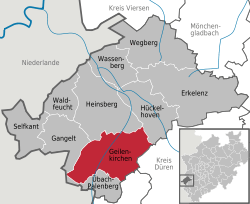Geilenkirchen
| Geilenkirchen | ||
|---|---|---|
| ||
 Geilenkirchen | ||
Location of Geilenkirchen within Heinsberg district  | ||
| Coordinates: 50°57′55″N 6°07′10″E / 50.96528°N 6.11944°ECoordinates: 50°57′55″N 6°07′10″E / 50.96528°N 6.11944°E | ||
| Country | Germany | |
| State | North Rhine-Westphalia | |
| Admin. region | Köln | |
| District | Heinsberg | |
| Government | ||
| • Mayor | Thomas Fiedler (Ind.) | |
| Area | ||
| • Total | 83 km2 (32 sq mi) | |
| Population (2013-12-31)[1] | ||
| • Total | 26,626 | |
| • Density | 320/km2 (830/sq mi) | |
| Time zone | CET/CEST (UTC+1/+2) | |
| Postal codes | 52511 | |
| Dialling codes | 02451; 02453; 02462 | |
| Vehicle registration | HS, ERK, GK | |
| Website | www.geilenkirchen.de | |
Geilenkirchen (German pronunciation: [ˈɡaɪlənkɪʁçən]) is a town in the district Heinsberg, in North Rhine-Westphalia, Germany. It is situated near the border with the Netherlands, on the river Wurm, approx. 15 km north-east of Heerlen and 20 km north of Aachen.
It was the site of Operation Clipper in November 1944.
The town gives its name to nearby NATO Air Base Geilenkirchen. The base is home to 17 E-3A airborne early warning and control aircraft manned by crews from 14 nations.
| ||||||||
Trade and Economy
Of importance are for example:
References
- ↑ "Amtliche Bevölkerungszahlen". Landesbetrieb Information und Technik NRW (in German). 4 September 2014.
